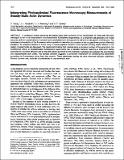Interpreting Photoactive Fluorescence Microscopy Measurements of Steady-State Actin Dynamics
Author(s)
Tardy, Y.; McGrath, J.L.; Hartwig, J.H.; Dewey, C.F.
DownloadTardy-1995.pdf (900.1Kb)
Metadata
Show full item recordAbstract
A continuum model describing the steady-state actin dynamics of the cytoskeleton of living cells Has been
developed to aid in the interpretation of photoactivated fluorescence experiments. In a simplified cell geometry, the model
assumes uniform concentrations of cytosolic and cytoskeletal actin throughout the cell and no net growth of either pool. The
spatiotemporal evolution of the fluorescent actin population is described by a system of two coupled linear partial-differential
equations. An analytical solution is found using a Fourier-Laplace transform and important limiting cases relevant to the
design of experiments are discussed. The results demonstrate that, despite being a complex function of the parameters, the
fluorescence decay in photoactivated fluorescence experiments has a biphasic behavior featuring a short-term decay
controlled by monomer diffusion and a long-term decay governed by the monomer exchange rate between the polymerized
and unpolymerized actin pools. This biphasic behavior suggests a convenient mechanism for extracting the parameters
governing the fluorescence decay from data records. These parameters include the actin monomer diffusion coefficient,
filament turnover rate, and ratio of polymerized to unpolymerized actin.
Description
Biophysical Journal, 1995
Date issued
1995Department
Massachusetts Institute of Technology. Department of Mechanical EngineeringPublisher
Biophysical Society
Citation
Biophysical Journal, 69, 1674-1682, (1995)
Keywords
actin dynamics, cytoskeleton, photoactivated fluorescence